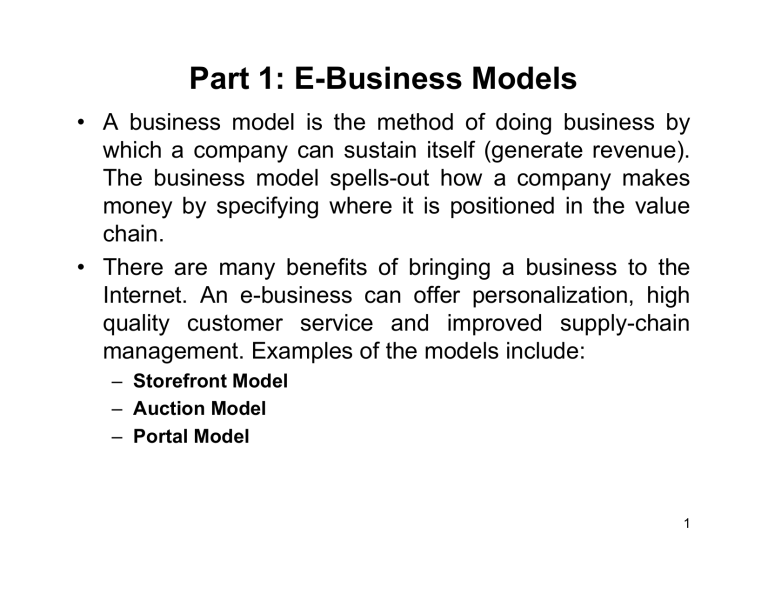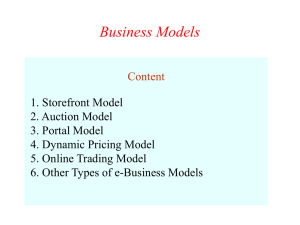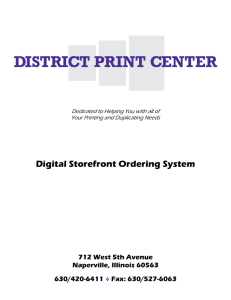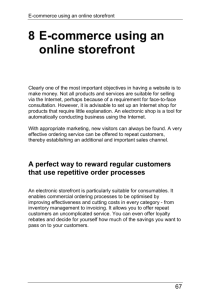Part 1: E-Business Models

Part 1: E-Business Models
• A business model is the method of doing business by which a company can sustain itself (generate revenue).
The business model spells-out how a company makes money by specifying where it is positioned in the value chain.
• There are many benefits of bringing a business to the
Internet. An e-business can offer personalization, high quality customer service and improved supply-chain management. Examples of the models include:
– Storefront Model
– Auction Model
– Portal Model
1
Storefront Model
• This model is a basic form of e-commerce in which the buyer and the seller interact directly.
• It combines transaction processing, security, online payment and information storage to enable merchants to sell their products online.
• To conduct storefront e-commerce, merchants need to organize online catalogs of products, take orders through their Web sites, accept payments securely, send merchandize to customers and manage customer data.
• The storefront should be marketed to potential customers. Many of the leading storefront model companies are B2C (Business to consumer).
• Examples:
– www.more.com (health and beauty e-commerce)
– www. moviefone.com (movie tickets, reviews, movie clips and trailers).
2
Shopping-Cart Technology
• One of the most commonly used e-commerce enablers is the shopping cart. This order-processing technology allows customers to accumulate items they wish to buy as they continue to shop.
• Supporting the shopping cart is a product catalog, which is hosted on the merchant server in the form of database .
• The merchant server is the data storage and management system employed by the merchant. It is often a system of computers that conduct all of the functions necessary for running a Web site.
• A database is a part of the merchant server designed to store and report on large amounts of information.
• For example, a database for an online clothing retailer would typically include such product specifications as item description, size, availability, shipping information, stock level, and on-order information.
• e-businesses that use shopping-cart technology, visit www.amazon.com
; www.etoys.com
; www.cdnew.com
.
3
Amazon.com
• Amazon.com
is a good example of an e-business that uses shopping-cart technology.
• Founded in 1994, the company has grown up to become one of the world’s largest online retailers.
• Its product line serves as a mail-order book retailer. It expanded to include music, videos, DVDs, electronic cards, consumer electronics, hardware, tools, beauty items, and toys.
• Amazon.com uses a database on the server side (the merchant’s computer system) that allows customers on the client-side (the customer’s computer, handheld device, etc.) to search for products in various ways.
• Amazon.com
database consists of product specifications, availability, shipping information, stock levels, etc.
• The database keeps records of all previous transactions including items purchased, shipping and credit-card information.
4
Online Shopping Malls
• Online shopping malls present consumers with a wide selection of product and services.
• Consumers can find products from a wide variety of vendors, and rather than making several separate purchases, they can use the mall’s shopping-cart technology to purchase items from many stores in a single transaction.
• Often these online shopping-mall sites act as shopping portals, directing traffic to the leading retailers for a specific product.
• Examples of shopping malls include: www.mall.com
; www.gap.com
; www.shopnow.com
; www.dealshop.com
.
5
Auction Model
• The Web offers many kinds of auction sites that search other auction sites to pinpoint the lowest prices on an available item.
• Auction sites act as forums through which Internet users can assume the role of either seller or bidder.
• As a seller, you post an item you wish to sell, the minimum price your require to sell your item and, deadline to close the auction, and many other features depending on the site.
• eBay is one of the most profitable online auction models. On eBay, people can buy and sell just about anything. The company collects a submission fee, plus a percentage of the sale amount.
• eBay uses a database to manage the millions of auctions it offers.
This database evolves dynamically as sellers and buyers enter personal identification and product information.
6
Portal Model
• Portal models give the visitors the chance to find almost everything they are looking for in one place. They often offer news, sports, and weather information, as well as the ability to search the web.
• Examples include www.hotbot.com
; www.about.com
; www.altavista.com
; www.ask.com
; www.yahoo.com
; www. agilesysllc.com. These portals provide users with a shopping page that links them to thousands of sites carrying a variety of products.
• Portals links consumers to online merchants, online shopping malls, and auction sites. They help users collect information on an item for which they are looking and allow users to browse independently owned storefronts.
7











